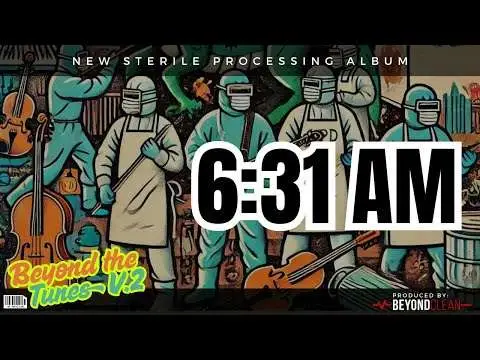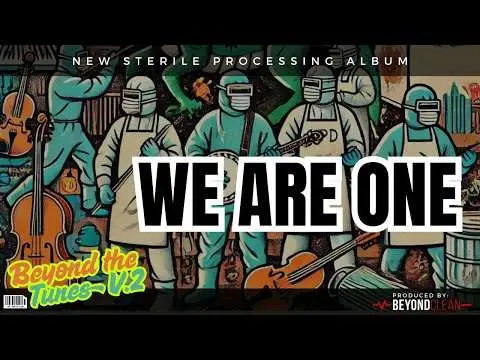Beyond the Tunes
Beyond the Tunes (A Sterile Processing Album)

So Clean (Track 1) | Beyond the Tunes
To celebrate International Beyond Clean Day 2022, we are excited to release an exclusive album dedicated to our Sterile Processing heroes and #CleanFreaks around the globe who fight dirty, every instrument every time. Thanks for all you’ve done for us over the past five years since we launched Beyond Clean in 2017 by helping us create the leading digital platform for education, engagement, and inspiration in the medical device reprocessing industry! We can’t wait to see what’s in store for the years to come!
Until then, keep fighting dirty, TURN UP THE VOLUME and enjoy Track 1 from Beyond the Tunes, entitled “So Clean.”
Additional album tracks will be releasing throughout the day!
#BeyondTheTunes #BeyondCleanDay #BeyondClean #WeFightDirty #WeEducateDifferently #SterileProcessing #Heroes #Recognition #Value #Respect

Pay Day (Track 2) | Beyond the Tunes
To celebrate International Beyond Clean Day 2022, we are excited to release an exclusive album dedicated to our Sterile Processing heroes and #CleanFreaks around the globe who fight dirty, every instrument every time. Thanks for all you’ve done for us over the past five years since we launched Beyond Clean in 2017 by helping us create the leading digital platform for education, engagement, and inspiration in the medical device reprocessing industry! We can’t wait to see what’s in store for the years to come!
Until then, keep fighting dirty, TURN UP THE VOLUME and enjoy Track 2 from Beyond the Tunes, entitled “Pay Day.”
Additional album tracks will be releasing throughout the day!
#BeyondTheTunes #BeyondCleanDay #BeyondClean #WeFightDirty #WeEducateDifferently #SterileProcessing #Heroes #Recognition #Value #Respect

Playing Second Fiddle (Track 3) | Beyond the Tunes
To celebrate International Beyond Clean Day 2022, we are excited to release an exclusive album dedicated to our Sterile Processing heroes and #CleanFreaks around the globe who fight dirty, every instrument every time. Thanks for all you’ve done for us over the past five years since we launched Beyond Clean in 2017 by helping us create the leading digital platform for education, engagement, and inspiration in the medical device reprocessing industry! We can’t wait to see what’s in store for the years to come!
Until then, keep fighting dirty, TURN UP THE VOLUME and enjoy Track 3 from Beyond the Tunes, entitled “Playing Second Fiddle.”
Additional album tracks will be releasing throughout the day!
#BeyondTheTunes #BeyondCleanDay #BeyondClean #WeFightDirty #WeEducateDifferently #SterileProcessing #Heroes #Recognition #Value #Respect

Millions of Stars (Track 4) | Beyond the Tunes
To celebrate International Beyond Clean Day 2022, we are excited to release an exclusive album dedicated to our Sterile Processing heroes and #CleanFreaks around the globe who fight dirty, every instrument every time. Thanks for all you’ve done for us over the past five years since we launched Beyond Clean in 2017 by helping us create the leading digital platform for education, engagement, and inspiration in the medical device reprocessing industry! We can’t wait to see what’s in store for the years to come!
Until then, keep fighting dirty, TURN UP THE VOLUME and enjoy Track 4 from Beyond the Tunes, entitled “Millions of Stars” written & performed by Regan Wakeman.
Additional album tracks will be releasing throughout the day!
#BeyondTheTunes #BeyondCleanDay #BeyondClean #WeFightDirty #WeEducateDifferently #SterileProcessing #Heroes #Recognition #Value #Respect

Go Beyond (Track 5) | Beyond the Tunes
To celebrate International Beyond Clean Day 2022, we are excited to release an exclusive album dedicated to our Sterile Processing heroes and #CleanFreaks around the globe who fight dirty, every instrument every time. Thanks for all you’ve done for us over the past five years since we launched Beyond Clean in 2017 by helping us create the leading digital platform for education, engagement, and inspiration in the medical device reprocessing industry! We can’t wait to see what’s in store for the years to come!
Until then, keep fighting dirty, TURN UP THE VOLUME and enjoy Track 5 from Beyond the Tunes, entitled “Go Beyond” written and performed by Katie Eckeberger.
Additional album tracks will be releasing throughout the day!
#BeyondTheTunes #BeyondCleanDay #BeyondClean #WeFightDirty #WeEducateDifferently #SterileProcessing #Heroes #Recognition #Value #Respect

It Doesn’t Always Have to Be This Way (Track 6) | Beyond the Tunes
To celebrate International Beyond Clean Day 2022, we are excited to release an exclusive album dedicated to our Sterile Processing heroes and #CleanFreaks around the globe who fight dirty, every instrument every time. Thanks for all you’ve done for us over the past five years since we launched Beyond Clean in 2017 by helping us create the leading digital platform for education, engagement, and inspiration in the medical device reprocessing industry! We can’t wait to see what’s in store for the years to come!
Until then, keep fighting dirty, TURN UP THE VOLUME and enjoy Track 6 from Beyond the Tunes, entitled “It Doesn’t Always Have to Be This Way.”
Additional album tracks will be releasing throughout the day!
#BeyondTheTunes #BeyondCleanDay #BeyondClean #WeFightDirty #WeEducateDifferently #SterileProcessing #Heroes #Recognition #Value #Respect

Wildfire (Track 7) | Beyond the Tunes
To celebrate International Beyond Clean Day 2022, we are excited to release an exclusive album dedicated to our Sterile Processing heroes and #CleanFreaks around the globe who fight dirty, every instrument every time. Thanks for all you’ve done for us over the past five years since we launched Beyond Clean in 2017 by helping us create the leading digital platform for education, engagement, and inspiration in the medical device reprocessing industry! We can’t wait to see what’s in store for the years to come!
Until then, keep fighting dirty, TURN UP THE VOLUME and enjoy Track 7 from Beyond the Tunes, entitled “Wildfire” written & performed by Flora Heinasuo.
Additional album tracks will be releasing throughout the day!
#BeyondTheTunes #BeyondCleanDay #BeyondClean #WeFightDirty #WeEducateDifferently #SterileProcessing #Heroes #Recognition #Value #Respect

Major Tray (Track 8) | Beyond the Tunes
To celebrate International Beyond Clean Day 2022, we are excited to release an exclusive album dedicated to our Sterile Processing heroes and #CleanFreaks around the globe who fight dirty, every instrument every time. Thanks for all you’ve done for us over the past five years since we launched Beyond Clean in 2017 by helping us create the leading digital platform for education, engagement, and inspiration in the medical device reprocessing industry! We can’t wait to see what’s in store for the years to come!
Until then, keep fighting dirty, TURN UP THE VOLUME and enjoy Track 8 from Beyond the Tunes, entitled “Major Tray,” written & performed by Ezra James Imperial.
Additional album tracks will be releasing throughout the day!
#BeyondTheTunes #BeyondCleanDay #BeyondClean #WeFightDirty #WeEducateDifferently #SterileProcessing #Heroes #Recognition #Value #Respect
Beyond the Tunes Vol. 2: The Sterile Processing Album

Sharps in the Dark: Beyond the Tunes Vol. 2
There are few more dangerous places to work in our nation’s hospitals than the decontamination room of a Central Sterile department. The opportunity for bloodborne pathogen exposure is ever-present, and yet many CS/SPD technicians are daily put at risk of injury by unsafe post-operative instrument preparations. Let’s take a look at the four most common dangers and how we can work together as a periOperative team to protect our people:
1) Blades
The Situation: Any surgical tray that includes a knife/scalpel handle (such as a #3, #4, #7, or microsurgical beaver handle) can immediately become a sharps risk when the knife blade is not removed from the instrument prior to returning the tray to your CS/SPD decontamination area. Although there are sharps removal protocols in most ORs, finding a blade at the bottom of a messy instrument tray is not an uncommon occurrence for some Sterile Processing departments. This danger multiplies as these blades are often difficult to see through typical plastic face shields worn by decontamination technicians and are even more difficult to safely remove while wearing slippery head-to-toe PPE.
The Solution: Post-op counts of blades must only happen after they are removed from knife handles. This will ensure the OR unintentional retention of foreign objections (URFOs) count is accurate, while also keeping your team members in SPD safe from stray blades.
2) Needles
The Situation: Though less common than blades, suture needles also pose a serious risk to your CS/SPD team when they make their way back to decontam after a surgical procedure. Typically, when these sharps are encountered by a decontamination technician, they are still locked in the jaws of a needleholder or floating near the bottom of a surgical tray (sometimes with suture still attached). Because of their minute size and ability to easily puncture a latex glove, suture needles must be handled with the utmost care – during both the removal from the needleholder and while untangling suture out of an instrument stringer. Still, seeing needles before they injure a decontamination technician is the most important part.
The Solution: Similar to the protocol referenced in #1 above (Blades), the best way to prevent needles from unintentionally endangering decontamination technicians is to require that these sharps be counted only after they are removed from the jaws of a needleholder. After this count, they should immediately be discarded into the sharps container in the operating suite.
3) Ring-handled Instruments
The Situation: Out of the four sharps dangers listed in this article, poor post-operative preparation of ring-handled instruments are by far the most common sharps risk that Sterile Processing professionals will encounter. The root causes for the likelihood of this decontamination hazard span the spectrum from overloaded instrument stringers to, well, a lack of adequate stringers in general — and a host of reasons in between. Whatever the cause, it is an almost universal reality to find surgical trays returned to CS/SPD with the sharp distal tips of ring-handled instruments precariously pointed up, out, and even toward the handles of their transport baskets and containers. An instrument as benign as an Ochsner-Kocher clamp that is improperly restrung can puncture a technician’s hand in an instant and expose them to any number of deadly bloodborne pathogens.
The Solution: While deceptively simple, the solution to this decontam danger has cultural and technological components. First, restringing of ring-handled surgical instruments must become the cultural norm in our operating rooms. While every second counts for the bottom-line of room turnover metrics, every second also counts for the safety of our CS/SPD teams who will receive these trays. Secondly, surgical trays – and in particular, surgical stringers – must catch up with the 21st century. The stringer technologies of our grandfathers may not be the best way to enable OR teams to safely return instruments to their decontamination counterparts. Solutions like Restore Medical’s stringer technology are moving us in the right direction.
4) Loose Instruments
The Situation: Surprisingly enough, during my career as a Sterile Processing leader, I have seen more decontamination exposures due to loose instrument sharps than the other three dangers combined. Sharp towel clips, skin hooks, and even finely tipped forceps lead the field for the “Most Likely to Send a Technician to the Employee Health Office” award. While many of these items are sent to the OR in disposable sterilization bags or fitted with tip-protectors, the instruments are often returned to CS/SPD loose in the bottom of the surgical tray… [Read the full article here: https://www.beyondcleanmedia.com/post/i-will-cut-you]

6:31AM: Beyond the Tunes Vol. 2
“It’s 6:31 am.
The first case in OR 3 is scheduled to start at 7 am.
The OR tech can’t find the trays.
The Vendor can’t find the trays.
The SPD can’t find the trays.
The patient has been nervously anticipating this surgery for weeks.
They and their spouse took off work to drive in the night before so they could be at the hospital on time for registration, pre-op, and are ready to roll back to the OR room.
But it’s 6:31 am and no one can find the trays.
The surgeon already consulted with the patient around the approach and procedure earlier in the week.
The vendor was notified which implants would be used, and the trays were shipped from the warehouse across the country for this specific patient.
Every one is shuffling around the OR and hallway.
But it’s 6:31am and no one can find the trays.
This story is NOT fiction.
This reality plays itself out each and every day at facilities across the US.
All the wheels of surgery are put into the play from initial consult, scheduling, pre-approvals, and more all the way to the “big day” — only to show up to the OR to hear “we can’t find the trays.”
Who’s fault is it?
Come now, let us reason together.
This is not a “who” problem.
This is a systemic problem.
To date, the only sure-fire solution is total chain of physical custody (typically by the Vendor rep) from the time of delivery, through reprocessing, from SPD to the OR, and then to the specific room. But this process is an unscalable, unattainable manual process, again — wholly dependent on the presence of the vendor rep. Even with this manual process, trays still get “lost” between the time the rep leaves the hospital at 11pm before they return at 5:30am the next morning.
Yes, current tech has come a loooong way with surgical instrument tracking, vendor tray management, scheduling interfaces, and more. But we’re not (quite) there yet in hardwiring this chain of custody.
Calling all #medtech innovators.
We need your help at 6:31 am tomorrow morning.”
-Hank Balch
#sterileprocessing
Follow us today:
Facebook: http://www.facebook.com/BeyondCleanPodcast
Linkedin: https://www.linkedin.com/company/beyondclean
Twitter: https://twitter.com/BeyondCleanInfo
Instagram: https://www.instagram.com/beyondcleanpodcast
Home Page: http://beyondclean.net
Apple Music: http://apple.co/2xzxECU
Stitcher: https://lnkd.in/e4hU6Pp
Google Play: https://bit.ly/2LY5pss
Spotify: https://spoti.fi/2nbJRcJ

Front Page Test: Beyond the Tunes Vol. 2
“I’ve got a very simple test I like to share with Hospital Administrators, SPD managers, and Quality & Risk personnel when I get questions about “if this instrument can be used on a patient”…
I call it “The Newspaper Test.”
Here’s how it works.
When someone brings you an instrument with a questionable issue:
👉 Maybe there’s cracking instrument marking tape
👉 Maybe the jaws are not quite aligned
👉 Maybe there’s a minuscule chip out of the jaw of the needle holder
👉 Maybe there cord has become randomly ‘sticky’ for some reason
👉 Maybe there was (so called “sterile bone”) found inside
etc., etc., etc.
I simply ask, “Would you be comfortable taking a photo of this issue and putting it on the front page of your local newspaper?”
The answer is always, instantly, 100% of the time “NO!”
And this exchange highlights one of the many things that is so broken about healthcare these days. At a high level, we (as an entire clinical profession) are far too comfortable doing things behind closed doors that we would not be comfortable putting in front of patients or the public.
More and more of us are growing bolder and more willing to “stop the line” in these instances. But at the same time, health systems are bold in their own way of firing those who are brave enough to speak up.
I do wish more people would use the newspaper test.
And I wish more newspapers knew what was going on in SPD.
Not because they get the reporting and facts right (because most of the time they do not), but because the patient on Main Street deserves to know the real state their instruments are in before they get an SSI…
Transparency on this topic is an undeniable good.
So why are we so unwilling to pursue it?
What say you?”
– Hank Balch

More than Meets the Eye: Beyond the Tunes Vol. 2
We need more (informed) eyes 🔬 👀 on surgical instruments before they get packaged and processed on their way into the Operating Room.
👉 The reality is this:
The life of a surgical instrument is “nasty, brutish, and short,” to steal a phrase from the philosopher Thomas Hobbes.
These little stainless steel (or some times plastic, titanium, or even wood!) devices undergo an absolutely brutal journey to and from the OR every single day. They are jostled, torqued, manipulated, tangled, clamped, set up and torn down, covered in bodily fluids, drenched in chemicals, attacked with water/pressure/ultrasonic waves, exposed to high temperatures, constantly rubbing up against other instruments and transport baskets, and on and on.
Is it any surprise they trend toward damage?
Knowing this (as all members of the hashtag#SterileProcessing team do), we should, in some sense, train our assumptions to “expect damage” and non-conformance during the assembly stage, instead of being surprised by it.
Instead of approaching the prep/pack phase as “ensuring there is no damage or residual debris” (which is assuming conformance) perhaps we should approach it as determining “where the damage and debris in this tray is” (which is assuming non-conformance).
Maybe we find damage, maybe we don’t. But the second approach takes into account how “nasty, brutish, and short” the instrument life cycle really is.
I noted in the intro that “We need more informed eyes” on these instruments. I mean that in two ways:
💡 1) Eyes of technicians who are more thoroughly trained to look for and identify instrument non-conformance during the assembly stage AND the tools they need to do that more effectively (such as lighting, magnification, and even microscopes – https://a.co/d/dkW8KGO)
💡 2) Technological “eyes” such as machine vision that is trained (by the folks in the first point above) to identify debris, damage, and other non-conformance at a much faster, more consistent speed.
The current state of affairs is that much of our surgical instrument flow DO not receive the detailed inspection that it and our patients deserve simply due to a lack of TIME, TOOLS, and TRAINING. Most every technician in our industry will admit that this is the case.
But we will also admit that effective inspection has the potential to save lives, and ineffective inspection has the potential to lose them.
Which path will you choose today?
And what more can industry do to make it easy to do the right thing?
What say you?

The Price We Pay: Beyond the Tunes Vol. 2
“Every now and then a little article or two or three hundred will pop up on Linkedin with some kind of variation of “People don’t leave jobs, they leave toxic cultures” or “People don’t leave companies, they leave bad managers.” If you’ve spent any time on this platform, you’ve probably seen it — and maybe even shared it (It’s okay, I forgive you).
One of the reasons for the viral nature of these articles is that we’ve all experienced the tremendously negative impact of a bad boss and/or a toxic workplace culture. So far, it’s all true enough. People sometimes do leave because they can’t stand their manager or because they are tired of being ignored, belittled, and otherwise taken advantage of.
But here’s the deal guys – it’s simply untrue to say that people never leave jobs for any other reason, because….actually they DO. Even a “winning culture” with bosses who would do anything to see their people succeed, can’t overcome inherent short-comings about certain jobs and industry scenarios that a simple cliché about toxic cultures can’t explain.
Our little niche of Sterile Processing is a prime example worth considering:
The work is hard – manual cleaning, lifting, pushing, loading, carrying, and standing for long periods of time.
The work is dangerous – sharps risk are a constant threat with every imaginable blood borne pathogen just waiting to pierce through PPE in the decontamination phase.
The importance is paramount – literal life & death hinge on our ability to adequately clean, inspect, package, sterilize, and store medical devices for every type of surgery under the sun — from appendectomies to heart transplants. One failure can have dire consequences.
The pay is laughable – considering the risks to employees and the value given to health systems, the inexcusably low pay scale typically can’t even compete with local hardware stores or entry level retail positions. Some barely hover above minimum wage.
The career ladder is short and broken – growth in this industry is limited to different levels of technicians (I, II, III, etc), supervisors, managers, and directors with many facilities having only a single supervisor or lead technician — and even most of these leadership positions are paid below their hospital peers in the OR & Supply Chain.
Considering all of this, we should not be surprised to see so many high performing technicians simply decide to pull the plug on a career in Sterile Processing to go on to do something else. These folks aren’t primarily leaving any broken culture or backward manager — they really are leaving a JOB. And who among you can blame them?
If we want to stop this brain-drain and talent-drain from the CS/SPD industry, simply blaming bad cultures and bosses will never get us there. First and foremost, we need to honestly and earnestly take a look at the job itself, and get to work fixing all the reasons that great technicians are leaving our department in droves. Are there HR reasons that people leave SPD? Of course. But they are not the only reasons, and I would argue they are not even the most important ones.
It’s easy to look at someone else and say “I can’t believe they would treat a worker like that.” It’s much harder and more convicting to ask, “Why would anyone ever want to do this job in the first place?” Leaders in the Sterile Processing industry should be laboring each and every day to develop innovations and processes that make these jobs easier, safer, more efficient, better compensated, and positioned for growth. There are all kinds of different jobs that someone could do to feel fulfilled and find purpose. Our challenge is to build an industry where the best and the brightest want to come and stay in Sterile Processing, not get burned out and leave.
What say you?”
– Hank Balch

No Such Thing As Small: Beyond the Tunes Vol. 2
There are no little places or little people in the world of Sterile Processing.
Every safe surgery we support – from a simple incision to the most complex pediatric heart procedure – is big deal. Each and every patient matters. Your facility may not cast a large shadow in an industry that highlights sprawling health systems and high-powered GPOs, but you can stand as a beacon of hope and healing to those patients who need immediate access to care, right where they are. Your “volumes” may be low, but your “value” to these patients and their families is just the opposite.
So, in light of this understanding, how are CS professionals, leaders, and vendors to think about these outposts of the Sterile Processing kingdom, dotting the landscape from the back roads of rural America to the main streets of Small Town, USA?
1) Ground Zero for Getting it Right
While smaller CS departments are by no means exempt from the common process challenges of their larger counterparts, many surgery centers and clinics have the ability to lock-down their processing systems in a way that big city hospitals could only dream about. CS technicians in these facilities tend to have much closer relationships with their OR peers, less diverse of an instrument inventory, and less complexity across the board – meaning, when these departments get it right, boy do they get it right! These small-scale success stories, when they happen, should be seen as models to be reproduced and examples to be emulated by their industry peers.
2) Specialization Stations
In addition to seeing smaller CS departments as more manageable “opportunities for excellence,” we should remember that many of these facilities (especially certain surgery centers) are prime locations for the specialization of CS professionals in particular service lines. A single technician who supports ten eye cases a day, five days a week, gains a level of “clinical-muscle memory” that is almost impossible for the average, general CS technician to gain at a larger facility. These specialists can learn to sense the smallest tug on a Vannas scissor or identify an incomplete cataract tray just by looking at it, driving up the quality of their surgical trays and driving down service defects. It’s no wonder that many CS professionals like this become beloved by the surgeons and OR teams that they support.
3) Incognito Ivory Towers
With the decrease in surgical variables found in smaller clinics and surgery centers, there is a prime opportunity for important CS-centered research to occur in partnership with these sterile processing teams. How long does a 53-instrument set take to process if you are actually following the manufacturer’s IFUs for decontamination, inspection, lubrication, and assembly? Is there a better way to provide a quality test to our rigid scopes prior to sterilization? While you may not get the big name facility noted on your study, you very well may get the big breakthrough on the next big product or process in the CS-universe. As the healthcare professionals at these facilities grow and move on, your rock-star research will follow in their wake. But more importantly, you will have made a real impact, on real patients, with real industry research to back it up.
——
Even apart from process improvement, specialization, and research opportunities, the wider focus for the CS-industry in regards to these far-flung processing locations should be one of constant recognition and remembrance. Industry importance should not measured by number of staff or size of department budget. Vendors who ignore or relegate these CS professionals to the back of the line in terms of educational support and follow-up, do so at their peril. Sure, you may be able to make a bigger sale at my 800-bed facility – but what are you going to do when I start asking about the last time you visited the surgery center on the outskirts of town? Not only should CS leaders at larger facilities lead by example in this area (offering support to their local clinic/surgery center peers), we should also make it clear that we will not allow vendors to gloss over the needs of those without the purchasing leverage and high-profile that we enjoy.
If we are going to go up in the industry, we must go up #Together.
No CS left behind!
What say you?

Ballad of the Microbe Slayers: Beyond the Tunes Vol. 2
“Fairy tales are more than true; not because they tell us that dragons exist, but because they tell us that dragons can be beaten.” – GK Chesterton
When it comes to story-telling, some of us in the healthcare profession pretend that such activity is the purview of kindergarten teachers and grandpas, but definitely not our job. Maybe the marketing department can handle it, but we’ve got fires to put out, root causes to analyze, new hires to on-board, and a host of other administrative duties that actually have an impact on patient care.
Well, what if I were to tell you that one of the most important things you can do today as an SPD leader is tell a story?
Not just any story, mind you, but a story that connects your people with their purpose — a story that pushes back against the darkness of the past and the monotony of the present, giving your team a vision of their glorious future.
But let’s stop there for just a moment. How did you feel when you read the word glorious above? Did its poetic spark get immediately extinguished by your own rationalization that the future of your team is many things, but glorious probably isn’t one of them? Or did that little thought sneak up behind you and fan the little flame of hope burning in your professional soul? Maybe our future is glorious? Maybe what we do today will really matter?
“If you don’t tell your story, someone else will.”
And these “alternative story-tellers”, we’ll call them, can come in many different forms. Perhaps it’s the grumbling old-timer on night shift who long ago gave up any faith in positive change. Or maybe it’s the OR coordinator who was burned one too many times by SPD service failures, so now his axe is on the constant lookout for a grinder. Or it could even be a hospital administrator behind closed doors who confides in his fellow leaders how broken the Sterile Processing team has become.
Ultimately, these are not the stories you want told about your team. And even if there is a hint of truth in them, they are not the whole truth, and they are definitely not the final truth. Owning your department’s story is not as much about controlling the message as it is about drafting the next chapter of your leadership vision and getting people to actually read it.
The Call to Action
So here’s my challenge to you today. Commit to owning the mantle of the Sterile Processing troubadour at your facility. Become your team’s poet laureate for excellent patient care through excellently processed surgical instrumentation. I’m not talking about literally taking up the microphone and going all Maya Angelou at your next staff meeting (although I’d love to see the video of that if you chose the path less traveled), but I am urging you to recognize the importance and power of narrative in our industry… [read the full blog here: https://lnkd.in/gYNxuTzE]
#SterileProcessing
Follow us today:
Facebook: http://www.facebook.com/BeyondCleanPodcast
Linkedin: https://www.linkedin.com/company/beyondclean
Twitter: https://twitter.com/BeyondCleanInfo
Instagram: https://www.instagram.com/beyondcleanpodcast
Home Page: http://beyondclean.net
Apple Music: http://apple.co/2xzxECU
Stitcher: https://lnkd.in/e4hU6Pp
Google Play: https://bit.ly/2LY5pss
Spotify: https://spoti.fi/2nbJRcJ

Survey Ready: Beyond the Tunes Vol. 2
“Let me just start this by saying there is no magic bullet for ensuring your department is ready for a Joint Commission or CMS survey. As ready as you think you are, there are always hidden issues lurking behind the next page of documentation or varying levels of confusion between your department’s policies and the real-life, daily application of them by your staff (AAMI and AORN resources are there for your more technical questions).
That being said, there are still a number of practical things Sterile Processing leaders should be aware of as they prepare for the end-all-be-all visit from JCo or CMS. If you’re like me, this is not an experience you just want to survive. It could mean your job, your reputation as a trusted expert or leader in your facility, and most importantly, it could mean your patients are not as safe as you thought they were. So let’s talk a little about how to ensure your SPD team thrives during their next survey.
Some Things Must Be Taught Not Caught
Don’t get me wrong, I’m a fan of cultural change via organic relationships within a department. Or in plain English — I’m okay with people learning by example — monkey see, monkey do. But when you’re preparing for a JCo survey, this reliance on more experienced technicians shepherding the department from shift to shift isn’t good enough. When a surveyor hits your processing area and asks one of your new technicians “How do you know how to properly process that Kelly Clamp?,” the answer, “Because if I have any questions I just ask Ms. Mary,” is not going to fly — and for obvious reasons. What happens when Ms. Mary is out on PTO or taking her lunch break? Even though this heavy reliance on seasoned technicians is a reality in a great many departments, it’s not going to give your surveyor any warm and fuzzy feelings, and that’s not a good sign of survey success. I believe your team can win or lose a survey by the competency of these conversations.
Even though most surveyors spend their time talking to front-line staff rather than high-level leadership, department leaders have everything to do with how those conversations go. Technicians are a reflection of their supervisors, managers, and directors. So if you want your techs to knock it out of the park, leaders have to be diligent to give them plenty of survey batting practice. Here are a few tips you should take under consideration:
1) Hire with Joint Commission in Mind
I’ve said it before, but I’m going to say it again: who you hire has everything to do with your department’s future success. And these JCo conversations are no different. As random as it may sound, you should be interviewing and hiring with Joint Commission conversations in mind. If given the proper education and training, could this candidate explain the sterilization process to a surveyor? Would this applicant have the confidence to converse with a team of facility leadership and surveyors about our sterilization recall policy? We’re not talking about hiring the next Winston Churchill or anything, but you owe it to your team to hire folks who could persuasively communicate who, what, why, and how you do what you do. If they can’t do this, it doesn’t matter how good your process is, the surveyor could walk away with concerns.
2) Take Them To the Water and Make Them Drink
As we discussed above, we can’t expect our technicians to just point and say, “She told me to do it this way,” to an inquiring surveyor.
We need self-contained fountains of Sterile Processing knowledge standing at every work station. As we all know, the only way to get that kind of knowledge out of someone is to get it in them first. To accomplish this, your department needs education — and a whole lot of it. It won’t do to simply have information available to them (in the form of certification books or manufacturer’s postings on the wall), you have to make them drink of this knowledge and do so on a regular basis. Requiring certification of your technicians is a great start to inculcating a level of expertise into your department’s culture. Requiring them to present an inservice or two during a department meeting each year is another great way to ensure they are thinking along the lines of why we do the things we do, not just how we do them. Have your supervisors utilize daily shift huddles to give policy reminders and mini-training sessions on proper documentation. And take the time to do random mock surveys with your team to determine weaknesses in individual knowledge or understanding. Remember, your team won’t go where you’re unwilling to take them… [read the full blog here: https://www.linkedin.com/pulse/forget-surviving-how-thrive-during-joint-commission-cms-balch/?trackingId=nVVmrHrgS66QGym6iJ0zuw%3D%3D]

We Are One, In the Fight to Sterilize: Beyond the Tunes Vol. 2
“That shift is a bunch of lazy bums!”
“They never do anything.”
“We always have to pick up their slack.”
Besides the occasional battle with the OR, internal SPD shift wars are one of the most common culture killers among instrument reprocessing teams. They are often some of the most frustrating challenges out there for department leaders, and one of the greatest sources for poor morale and internal conflict on the part of frontline technicians. Shift friction can undermine even the most intentional new technician onboarding programs and lead the best technicians to make poor decisions in moments when shift conflict sparks out of control.
In the midst of these warring factions, how do you reengage your team to focus on fighting the real enemy, dangerous microbial fire breathers, and not each other? Is there still hope for you to sign a peace agreement and declare a cease-fire in your department? You bet. And here are four secrets to making it happen.
Find the Truth, the Whole Truth, and Nothing but the Truth
These situations cannot be solved under threat of discipline or casual dismissal alone. Once the seeds of dissension and distrust have sprouted among your team, it must be dealt with in firmness inspired by wisdom. There are reasons that your second shift consistently throws your first shift under the proverbial bus, and you have to determine what those reasons are, both in reality and in perception. Does your third shift think they have unrealistic expectations of productivity put on them? Does your first shift leave their workstations looking like a supply bomb went off when they leave for the day?
These issues have to be dealt with truthfully and not by taking anything on hearsay alone. You must be willing to identify root causes of both behavior and process breakdowns.
Define Fairness and Slaughter that Ubiquitous Sacred Cow
If we distilled 90% of all shift-war activity down to one word, it could very well be the f-word. Yep, fairness. This is not fair. That is not fair. In the midst of it all, it’s forgotten that bickering over these kinds of things in an SPD causes the real unfairness—patients who aren’t getting 100% of our focus and commitment because we’re too busy comparing our workload or assignment to the workload and assignment of others.
Sterile processing departments and leaders who attempt to worship the mysterious idol of fairness will constantly find themselves in the midst of antagonistic comparisons by staff members or shifts who feel that it is their duty to ensure no one ever does more or less than their fair share. Is that our department’s mission statement? Is that our purpose as sterile processing professionals? This obsession with an ambiguous idea of fairness must be replaced with the larger values of professionalism, teamwork, and patient-centered work. This is the only way to rise above unhelpful comparisons.
Use the Language of Ownership and Oneness: They are We
You’ve handled the truth and left the idol of fairness smoldering in the hospital parking lot. Now what? Now comes the time to flip the department script. Chances are high if you are struggling through shift wars in your department that you are hearing a lot about they. You know, those other people different from us. The weirdos who can get up at 5:30 a.m. and be happy about it. Or those technicians who never work as hard as we do on our shift. It’s a conversation and language of division.
If they are not we, then it’s okay to blame them, shame them, and withhold mutual respect. That is why it’s critical that department leaders take control of this language and require every conversation to be a we conversation. If the work didn’t get finished last night, “We didn’t zero out.” If someone forgot to complete important documentation, “We did not fill out the temp/humidity log.” If your team is forced to own the work of their team members in the way they talk about it, it will go a long way in changing the way they think about it as well.
Clarify Expectations and Hardwire Personal Accountability
Let’s assume for the sake of this article that you have a shift that really is slacking off when it comes to productivity, communication, and policy compliance. Before you dust off the corrective action forms and start making calls to HR, you need to deal with two possible scenarios.
First, this shift may not be aware of the specific expectations it should be operating under. Are they supposed to leave decontam totally empty and prepped for the next day of surgical volume? Should they be pulling supplies for every posted case prior to handing off the reins to the next shift? Do they all know that? Are all the shifts aware of each of their particular expectations, especially if they are different from one another? If expectations are unclear, it can be a spark for unnecessary shift conflict… [read the full blog here: https://www.beyondcleanmedia.com/post/shift-wars]

ASC Wipeout: Beyond the Tunes Vol. 2
“Let’s be honest with ourselves for 1/2 a second here, folks.
👉 Attn: Surgeons, ASC Directors, Vendors Reps, Big Ortho, Regulatory, and my dear #CleanFreaks in SPD. 👇
There is not one person on planet earth who thinks it’s a good idea to dump tons of orthopedic tray volume on ASC reprocessing departments.
No one thinks it’s gonna be pretty.
No one thinks they are going to keep up.
No one thinks they are ready.
No one even thinks these ASC reprocessing “closets” were built with orthopedic volume in mind.
And yet here we are, all talking about how ASCs across the US will see 12 percent to 22 percent growth in volume the next 5 and 10 years. How data reveals a remarkable surge of 42,228 procedural cases reported by ASCs as of November 2023, a staggering 84% increase from 2022 (American Joint Replacement Registry 2023 Annual Report).
Not only that, but we saw a 293% increase in outpatient knee replacement procedures in the ASC market from 2019-2023.
Do you think we saw a 293% greater investment in SPD resources, space, training, technology, staffing, and more?
I would laugh, but this isn’t funny.
I can’t even say the volume is coming.
In many places it’s already there.
🙋♂️ How’d we end up here?
Lots of reasons, lots of market forces.
Some financial, some logistical, some patient preference, and more.
But one of the primary reasons we’ve ended up here as far as Sterile Processing is concerned, is that SPD was never really considered as a concern in the first place. Healthcare thought it’d be a good idea, and that we’d iron out the challenges later.
Well, I’m here to tell you, if you’re out there solving for this loaner volume challenge in the ASC market today, you are at the epicenter of opportunity, my friend. Whether it’s more efficient tray layouts, smarter tray logistics, better equipment layout, new off-site solutions, scaling up predictive data, and more — fixing this issue is going to need all hands on deck.
The rhino (or tidal wave of volume) ain’t slowing down anytime soon.
Until then, please, please, please remember these solo techs out there.
They are getting trampled, trounced, and bowled over.
They need every brilliant idea, tangible help, and inspiration we can give them.
Because they are one of the last stops on that tray’s journey from storage to sterile to surgery.
Are you out there saving the day in ASCs?
I’d love to hear what’s working for you and your SPD. 🙏 ”
– Hank Balch
Follow us today:
Facebook: http://www.facebook.com/BeyondCleanPodcast
Linkedin: https://www.linkedin.com/company/beyondclean
Twitter: https://twitter.com/BeyondCleanInfo
Instagram: https://www.instagram.com/beyondcleanpodcast
Home Page: http://beyondclean.net
Apple Music: http://apple.co/2xzxECU
Stitcher: https://lnkd.in/e4hU6Pp
Google Play: https://bit.ly/2LY5pss
Spotify: https://spoti.fi/2nbJRcJ

I Got It: Beyond the Tunes Vol. 2
“One of the most annoying sounds I’ve ever heard was the buzzer on the cart washer in my first hospital. Man, that thing sounded like a cricket the size of Godzilla was scratching its legs together—again, and again, and again. But as loud and annoying as the sound was, the buzzer also served as the impetus for one of my first experiences on the importance of sterile processing initiative that I had in my young career.
WHAT IT MEANT FOR ME
For technicians working in the clean assembly area, we knew what that buzzer sound meant. One of us had to stop what we were doing, walk all the way over to the cart washer, unload steaming hot carts, close the door, and walk all the way back to our table before trying to pick up where we left off. Because of the layout of prep and pack tables in the department, we knew certain people would be closer to the cart washer than others, so some of us made decisions about where we worked based on the unspoken expectation of who would probably be unloading the cart washer for the night.
All of this thinking was very me-centered. We knew that buzzer would interrupt what we wanted to do. It would slow us down from completing our trays or make us lose our place in checking off a count sheet. It might even interrupt a conversation we were having with our teammates. The buzzer did not care what we were doing, and we did not really have an option to ignore it, so we had to deal with it even if we were not happy about it.
WHAT IT MEANT FOR THEM
That was the perspective from the clean side. But for the technicians in the decontamination area, it was a completely different story. Every time the buzzer went off on the cart washer, it was a sign of coming relief from the overwhelming press of empty case carts waiting to be loaded into it for cleaning and thermal disinfection. Many times these technicians could hardly walk around their sinks due to the number of case carts being staged for washing.
Each time the buzzer sounded and carts were unloaded on the clean side meant a little more breathing room (and walking room!) for the team on the dirty side. With more space to maneuver, it was easier for these technicians to safely transfer trays from manual cleaning sinks into ultrasonic machines, and from ultrasonics into washer-disinfector equipment.
WHAT IT MEANT FOR US
Each buzzing cart washer signaled that more clean case carts would soon be ready for building by our case-picking team who were preparing the surgical cases for the following morning. There were many occasions when we did not have enough clean case carts available to keep up with the speed at which this team was picking surgical trays and disposable supplies. They could fill the carts quicker than our machine could wash them.
Until all the cases were pulled, these technicians could not begin working on the missing instrument list for the evening or transition back into the assembly area to assist in completing trays. The efficiency of their night rested heavily on the efficiency of that case cart cleaning process.
WHAT IT MEANT FOR THE PATIENT
Ultimately, all the implications of that annoyingly loud buzzer ended with a patient. At the end of the day, it wasn’t about any of us on the clean side, it wasn’t about any of them on the dirty side, or even about how efficient the rest of our team could be with our department duties. That buzzer forced us to make a decision about how much we valued Mr. Johnson’s total hip procedure on Thursday. It required us to be truthful about the real level of care we had for Mrs. Thompson’s open heart procedure at 7:00 a.m. tomorrow. It was more than the sound of clean carts; it was the sound of conscience, and each of us had to answer it.
Why INITIATIVE makes the world go ’round
What does all this have to do with initiative? It’s simple really. This little slice of the sterile processing experience, something as mundane as an alarming buzzer on a cart washer, has a way of separating the can-do and will-do personalities from the can’t-, won’t-, or won’t-do-it-with-a-smile-on-my-face members of our team. We learn a lot about the inner drive of the SPD technician who is the first to yell, “I got it!” when that buzzer goes off for the tenth time of the night. And we learn just as much about the technician who pretends to be too busy, too focused, or selectively deaf to the inconvenience that initiative calls them to take part in…”
[read the rest on our Beyond Clean blog here: https://www.beyondcleanmedia.com/post/i-got-it]
Follow us today:
Facebook: http://www.facebook.com/BeyondCleanPodcast
Linkedin: https://www.linkedin.com/company/beyondclean
Twitter: https://twitter.com/BeyondCleanInfo
Instagram: https://www.instagram.com/beyondcleanpodcast
Home Page: http://beyondclean.net
Apple Music: http://apple.co/2xzxECU
Stitcher: https://lnkd.in/e4hU6Pp
Google Play: https://bit.ly/2LY5pss
Spotify: https://spoti.fi/2nbJRcJ

Chipped Steel Blues: Beyond the Tunes Vol. 2
“Any volunteers out there to have this CHIPPED needle holder used on YOUR surgery? Because it was used on someone’s surgery, and was about to be used on someone else’s before I grabbed it during an on-site assessment. 😱 When I catch things like this, the scariest part is that no one ever knows where the rest of that tungsten carbide jaw insert is. Where did the chip go? One thing we do know, the last time it was used was holding a needle in an open incision for someone’s child, school teacher, grocery store clerk, or congressman. How do you think this chunk of metal behaves inside a wound?
Can we get even more real for a moment? Like the realest of reals?
I’d be willing to bet the farm that I could step into any Sterile Processing department in the country today (even my own back in 2017) and find CRACKED and CHIPPED needle holders in active circulation, sterilized, on the shelf, “patient-ready” for surgery. For some of you I may find only 1 or 2. Others, 30 or 40 critically compromised devices.
Why?
Well it ain’t because we’re not trying out there in Sterile Processing. And it’s definitely not because we don’t care.
Two of the first reasons that come to mind:
• Frontline technicians are not being given the TIME or TRAINING to adequately inspect every needle holder, every time — particularly under magnification.
• Even with the time and training, most departments do not have appropriate TOOLS or TECHNOLOGY to hardwire needle holder safety up to the level our patients deserves.
It’s a cold, hard truth. But it is the truth, nonetheless.
And unless more of us wave this red flag❗, we won’t ever get the support we need to solve it.
What say you?”
-Hank Balch
Follow us today:
Facebook: http://www.facebook.com/BeyondCleanPodcast
Linkedin: https://www.linkedin.com/company/beyondclean
Twitter: https://twitter.com/BeyondCleanInfo
Instagram: https://www.instagram.com/beyondcleanpodcast
Home Page: http://beyondclean.net
Apple Music: http://apple.co/2xzxECU
Stitcher: https://lnkd.in/e4hU6Pp
Google Play: https://bit.ly/2LY5pss
Spotify: https://spoti.fi/2nbJRcJ

Sweet Recognition: Beyond the Tunes Vol. 2
I’m not a cookie-hater. I just like some things more than cookies – like getting a shout out from the chief of surgery, or receiving a thank you note from the hospital president. I can get my own cookies at Walmart, but those other things are worth far more (to me) than 4 for a $1. But what do cookies have to do with recognition? (and why am I obsessed with talking about food and Sterile Processing?) Let’s get right into the meat of this foodie-inspired conversation.
To encourage all you cookie-lovers out there, I’ve got good news. Cookies aren’t always for chumps. But anyone — leader, frontline technician, coworker, or customer — who has ever gotten recognized for doing something great at works knows that people respond in different ways to different kinds of recognition. This next sentence is the entire point of this article: Successful recognition of your Sterile Processing team can not be cookie-cutter. There is no silver bullet (or chocolate chip cookie) that will hit everyone’s hunger for recognition in the same way. Sometimes cookies are just the ticket for making someone’s day in SPD. Other times they can totally miss the mark. Let me flesh this out a little bit more for those in the back:
1) Recognition from Leaders
There are some folks out there (like me!) who thrive off of recognition from their leaders – OR Managers, Directors, VPs of Surgical Service, and COOs, CEOs, and CNOs. Nothing hits the spot like my boss seeing something I did and taking the time to give me props for it. How they do it is not nearly as important as the fact that they do. No amount of other recognition types can compare to it.
2) Recognition from Co-Workers
Many of our department recognition programs are built around the concept of peer-to-peer or co-worker recognition. For some folks, this is where its at. They desire nothing more than working hard, having their team members notice, then getting recognized in front of that group of their peers. After all, no one really knows who is slacking and who is killing it except those folks who are actually right beside you doing the work. Yeah, it’s nice for these folks to get a shout out from the manager, but when everyone else thinks you’re doing a great job too, that’s what really gives them the juice they need to keep going.
3) Recognition from Customers
There are others on our team who don’t really care what the boss or their coworkers think about them, but they care very much about impressing their customers. These are the folks in Sterile Processing who are addicted to great customer service, and the feedback & recognition that comes when they go above and beyond to make sure the customer is happy with their Sterile Processing products. People like this can become very deflated and depressed if they give their jobs all they got, but never get that customer feedback they hunger for. No amount of manager pats-on-the-back or peer recognition can fill that customer-shaped void.
Recognition in Real Life
Those of you who are a little saucy this morning may be thinking, “That’s great Hank, different people value different types of recognition — tell me something I didn’t know.” Well, how about this gut check? There may be people on your team who haven’t been recognized for doing something positive in years. We don’t know what our technician’s lives are like when they go home. They may clock out of our SPD’s into a thankless world where no matter what they do, it never seems to be enough. Perhaps they are taken for granted by their spouses. Maybe they are treated like failures by their parents, or used by the folks they thought were their friends. And the one place they could find encouragement, refuge, and yes – recognition, is in your Sterile Processing department. But do they even find it there?
Nice people aren’t the only ones who deserve recognition. Even the trouble makers and complainers in our department do things that could be praised. In fact, folks on our teams may be angry and complaining specifically because of the lack of recognition they get outside and inside of work. But recognition can have a funny effect on people. It can actually change them. There’s a Bible proverb that says, “Pleasant words are as an honeycomb, sweet to the soul, and health to the bones.” (Prov 16:24) Anyone who has ever gotten recognition for something out of the blue knows that it is indeed sweet to the soul. And the more of it you get, the healthier your self-confidence becomes. You start to see your real value to the team. You begin to trust your contributions to the larger mission. In short, you feel recognition in your bones… [Read the full blog here: https://www.beyondcleanmedia.com/post/cookies-are-for-chumps-getting-sterile-processing-recognition-right]
